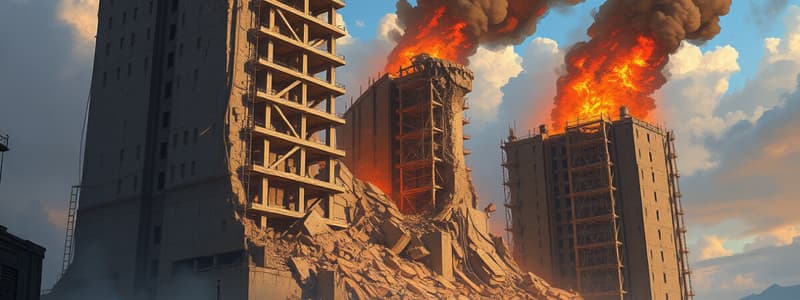Podcast
Questions and Answers
Match the types of building collapses with their descriptions:
Match the types of building collapses with their descriptions:
90-degree wall collapse = A collapse in which an entire wall fails as one unit. A-frame floor collapse = A collapse in which one end of the collapsed floor is supported by an interior wall. Global (total) collapse = Results in the complete failure of the building. Pancake collapse = A collapse of a building’s floors in a pancake stack fashion.
Match the types of floor collapses with their characteristics:
Match the types of floor collapses with their characteristics:
Lean-to-floor collapse = A collapse of a building’s floor in which one end is still supported. Cantilever floor collapse = A collapse in which one end of the floor is unsupported. Partial collapse = A failure of a portion of a building without total loss. Inward outward collapse = A collapse with the exterior wall failing horizontally.
Match the types of structural failures with the patterns of collapse:
Match the types of structural failures with the patterns of collapse:
Progressive collapse = Extensive failure initiated by local damage. Secondary collapse = An additional collapse that occurs after the initial one. Curtain wall collapse = The wall falls straight down like a curtain. Lean over collapse = Characterized by a building leaning into adjacent structures.
Match the collapse types with their implications:
Match the collapse types with their implications:
Match the collapse descriptions to their types:
Match the collapse descriptions to their types:
Match the collapses with the structure types they commonly relate to:
Match the collapses with the structure types they commonly relate to:
Match each collapse to its defining movement:
Match each collapse to its defining movement:
Match each type of collapse with its potential outcome:
Match each type of collapse with its potential outcome:
Flashcards are hidden until you start studying
Study Notes
Types of Building Collapses
- 90-Degree Wall Collapse: Entire wall fails uniformly as a single unit.
- A-Frame Floor Collapse: One end of the floor rests on an interior wall, creating two void spaces.
- Cantilever Floor Collapse: One side of the floor remains supported while the opposite side is unsupported, leading to potential voids.
- Curtain Wall Collapse: Common with brick veneer walls; the wall falls downward like a curtain.
- Global (Total) Collapse: Full structural failure of the entire building.
- Inward-Outward Collapse: Exterior wall fails horizontally while the interior wall folds, creating inward failure at the top and outward failure on the bottom.
- Lean Over Collapse: Found in wood-frame structures; upper levels lean into adjacent buildings or collapse entirely to the side.
- Lean-To-Floor Collapse: One end of a floor remains supported, creating a triangular void space due to the failure of another end.
- Pancake Collapse: Floors and roof collapse in a layered manner, stacking flat on top of each other.
- Partial Collapse: A section of the building fails without causing a total structural failure, yet can be as hazardous as a complete collapse.
- Progressive Collapse: Local damage triggers widespread structural failure through a sequence of connected failures.
- Secondary Collapse: Occurs after the initial collapse; additional structural failures result from shifting loads post-primary collapse.
- Situational Awareness: Refers to understanding environmental conditions in firefighting: spatial perception, comprehension of observations, and predicting outcomes of changes.
- V-Shaped Floor Collapse: Floor fails near the center, with unfailed perimeter support, creating two distinct void areas.
Studying That Suits You
Use AI to generate personalized quizzes and flashcards to suit your learning preferences.




